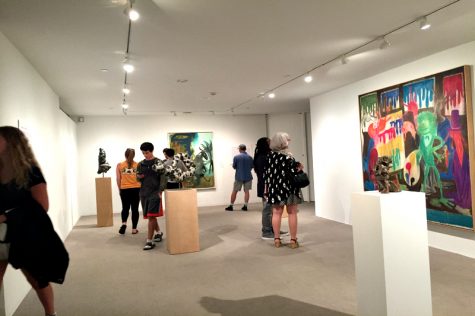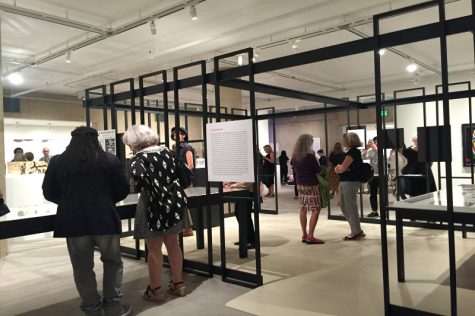New art exhibit on campus draws from the past, looks to the future
AMHERST — Artists and art-lovers from the University of Massachusetts Amherst and the surrounding community welcomed two new exhibits at the University Museum of Contemporary Art at the Fine Arts Center last week.
The exhibits commemorate Cobra, the abstract expressionist movement that brought optimism back to art after World War II.
The Wednesday opening of “Human Animals: The Art of Cobra” and “Cobra: Contemporary Legacy” drew more than 200 guests. The opening was followed by a one-day symposium Friday.
“Cobra isn’t just about history, but about looking around to what is happening now,” said Karen Kurczynski, assistant professor of art history and exhibit curator at the museum. “Look at how wars continue to exist. It’s not a return to peace. It’s a situation of constant war.”
Cobra is named after the the interdisciplinary European avant-garde movement. The name is a combination of the cities Copenhagen, Brussels and Amsterdam. It includes art on multiple mediums. From painters to poets, all came together with an optimistic determination to start over after World War II.
The exhibition features modern paintings, sculpture, and prints from artists inspired by the legacy of Cobra. It also includes primary documents by artists famous to the movement, such as Karel Appel, Corneille and Asger Jorn — who Kurczynski spent time with as a scholar before his death in 1973.
“I was very involved in sharing the collection of over 2,000 works because I believe it’s important to bring Cobra to Americans as much of the art is distributed around Europe,” Kurczynski said.

Much of the new exhibit at the University Museum of Contemporary Art takes the characteristics of the original movement, which hit its stride in the mid-1900s, and brings them into the world of contemporary art, such as Dutch artist Jacqueline de Jong’s dehydrated potatoes.
Jong’s pieces are featured in the “Cobra: Contemporary Legacy” segment of the exhibition. It brings the legacy of the movement to a contemporary lens. Her works vary with different mediums, though one piece of her work displayed in the exhibit stands out.
Glittery gold gleams from what looks like a misshaped brain. The truth of the mysterious object encased in the glass enclosure turns out to be gold cast from dehydrated potatoes. Jong explained she spent years growing the potato in her garden and preserving it for her ideal shape.
The Cobra movement seeks to connect to the political artistic context of today and generate new or unconventional approaches to the spontaneity, myth and folklore of art. It tells stories and explains a certain place in time in world history and compares it to the present and the future.
“When Karen came with me with this proposal to organize ‘Human Animals: The Art of Cobra’, I said to her, ‘This is an extraordinary opportunity,'” said Loretta Yarlow, museum director of the University Museum of Contemporary Art.
“It is a golden opportunity to look at its legacy because we’re a contemporary museum,” Yarlow added.

Jessica Chien, a senior Studio Art major at UMass, said she feels the Cobra exhibit, among others, are valuable resources to students.
“As student artists, it’s really important to dive into art history, learn about art history movements and learn what’s going on in the world,” said Chien.
The Cobra exhibits will continue through November 20. Entry is free of cost. For hours, visit the University Museum of Contemporary Art website.
Email Caeli at [email protected] or follow her on Twitter @caeli_chesin.











